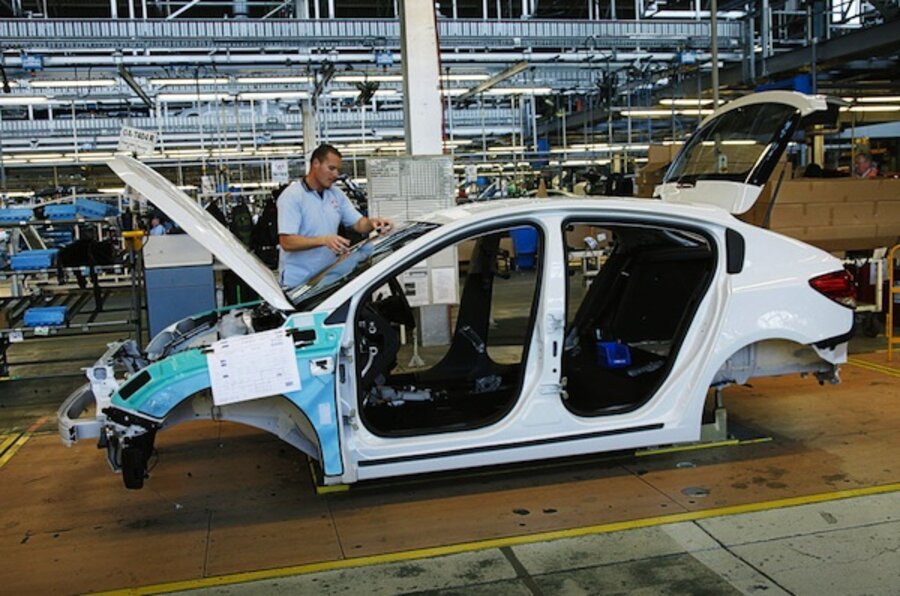As auto industry dies, Australia asks: Do we still make anything?
Loading...
| Sydney, Australia
Australians of a certain age can still sing the jingle for Holden cars, a national automobile icon. "We love football, meat pies, kangaroos, and Holden cars," ran the 1970s television ad.
Australia’s infatuation with "footy," fast food, and exotic fauna shows no sign of fading. But production of Holden’s gas-guzzling Commodore sedan, once the nation’s top-selling car, and its other models, will end in 2016, dealing a body blow to Australia’s pride in its industrial clout.
For a wealthy, sparsely populated country with bountiful natural resources for export, the bigger question is does it make sense to manufacture anything at all. “What do we do to pick up the slack in the economy, or do we over time become a country that stops making things?” asks Innes Willox, chief executive of the Australian Industry Group.
Holden is a subsidiary of General Motors, which announced Tuesday in Detroit that it was yanking its Australian assembly lines because they no longer made business sense. Indeed, Holden has been owned for decades by GM, giving it little or no leverage over decision making in a global industry.
GM Chairman and chief executive officer Dan Akerson said in a statement that the decision to close Holden’s plants was based on a “perfect storm of negative influences,” including the strength of the Australian dollar, the high cost of production, a small domestic market, and highly competitive and fragmented car market. In recent months GM has rationalized global production lines with cuts in South Korea, Europe, and the US.
Yet, despite its foreign ownership, Holden has retained a distinctive Australian look and feel that reflected the continent’s vast distances, rugged conditions and frontier spirit. The first bulbous-shaped Holden rolled off the assembly line in 1948, prompting Prime Minister Ben Chifley to exclaim: “She’s a beauty!”
At first Holden stuck to family cars such as the famous FJ sedan and pick-up trucks favored by farmers and workers, before branching out into everything from small hatchbacks to SUVs. Its brand was a paragon of Australia’s postwar manufacturing boom, which is why news of its death set off a storm of commentary in Australia’s raucous media.
Subsidies or sabotage
Much of the debate has centered on whether or not Australia’s federal government should have agreed to continue paying subsidies to the car industry in order to keep Holden afloat. The closure means that nearly 3,000 workers are losing their jobs and that a further 3,000 businesses that rely on auto manufacturing could be next to go.
Opposition leader Bill Shorten accused the government of "sabotage": “A major company that has been building motors cars in this country since after the Second World War has effectively been goaded to give up on this country,” Mr. Shorten said.
Prime Minister Tony Abbott admitted that it was a “bad day for everyone involved in the motoring industry,” but told Parliament: “There will be better days ahead. We will work with the creative people of this country.”
Australia's $19 billion (US dollars) auto manufacturing sector employs 50,200 workers, according to the Bureau of Statistics. Between 2001 and 2012 Holden received $1.9 billion in government subsidies and claimed it needed another $272 million a year to continue production.
Earlier this year Ford announced that it was phasing out production in Australia and putting more investment into lower-cost Thailand. Once Holden goes, Toyota will be the last major car firm manufacturing vehicles in Australia, but the Japanese manufacturer said it is now reassessing its future operations there.
The prospect of losing its entire car industry is a wakeup call for Australian industry, says Mr. Willox. “The ‘what’s next?’ question is the important one we need to address.” The way forward, he argues, is to rein in costs and make sure that other manufacturing giants do not give up on Australia.
“We need to put a cap on our cost base. We are one of the most expensive countries in the world in which to operate. That doesn’t mean we have to push salaries down, but unions need to see the light and that never-ending wage increases are making it difficult for businesses to operate here.”
Decline in manufacturing
In the 1950s manufacturing contributed 22.4 per percent to Australia’s economy, led by the automotive, heavy engineering, clothing and footwear industries. In 1958 Holden accounted for over 40 percent of total car sales in Australia.
But as Australia has grown rich from exporting vast quantities of coal, iron ore, and other minerals, with China emerging as its biggest trading partner, industry has taken a backseat. By the start of this decade, service industries such as retail, finance, education and tourism accounted for half of Australia’s GDP, with mining making up around 10 percent, outpacing manufacturing that is now less than 9 percent of the overall economy.
Holden’s slide has been just as severe with fewer than one-in-ten cars now sold in Australia carrying the distinctive "lion and stone" logo.
Sydney paramedic Ben Gilmour, who has owned five vintage Holdens, says he will miss the brand. “To me they part of the golden days of my childhood, the bush tracks and beach holidays. They are as iconic as [national airline] Qantas.”







